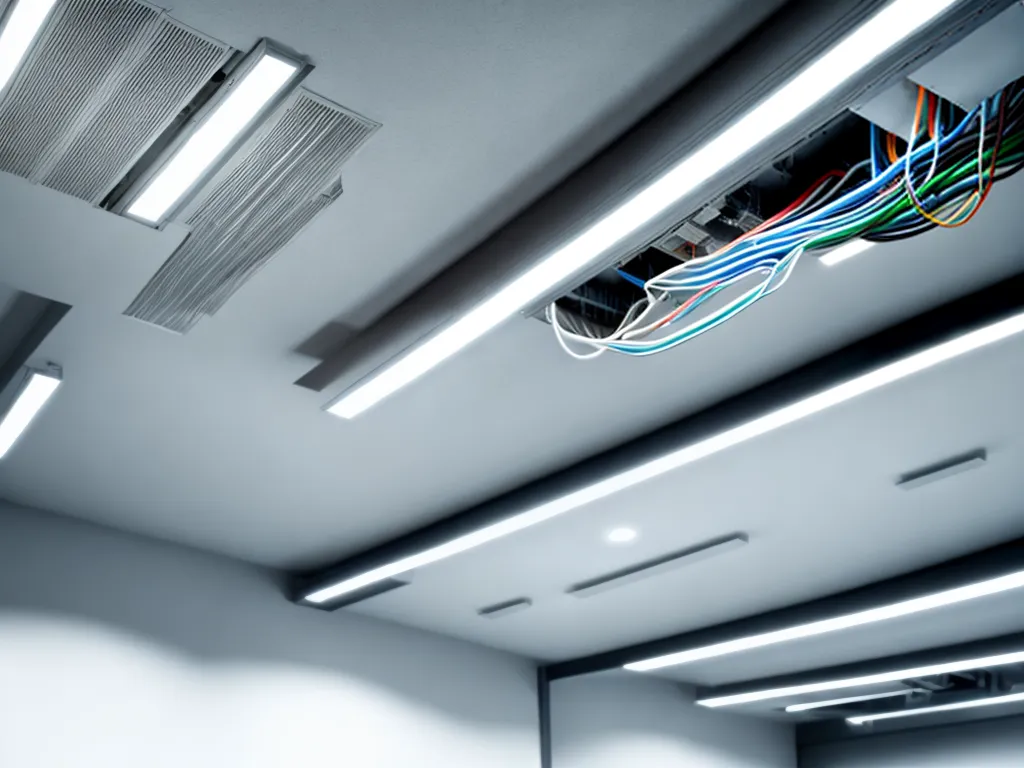
Low voltage wiring is essential for supporting technology, lighting, HVAC, security and other systems in modern commercial buildings. Selecting the right types of low voltage cabling and pathways allows building owners to future-proof their properties while meeting safety and performance standards. This article provides an in-depth look at the key factors in choosing low voltage wiring for commercial projects.
Categories of Low Voltage Wiring
There are several main categories of low voltage wiring used in commercial buildings:
Structured Cabling
This refers to the cabling infrastructure for telecommunications and data networks. It includes:
- Category 5e, 6 and 6a copper cabling - Used for 10/100/1000 Mbps Ethernet networks. Cat 6a supports 10 Gbps.
- Fiber optic cabling - Singlemode and multimode fiber options for high speed backbone connections.
- Coaxial cable - Used for older Ethernet networks, as well as cable TV and satellite connections.
A properly designed structured cabling system allows for easy upgrades as technology evolves.
Access Control and Security Wiring
This includes cabling for:
- Access control systems - Connect electronic access control panels, card readers, request to exit sensors, door locks and related hardware.
- Surveillance cameras - Run video cables from cameras to central security room.
- Intrusion detection - Connect devices like motion detectors, glass break sensors and door contacts.
The right security wiring prevents bottlenecks and limits while supporting expansion.
Lighting Control Wiring
Cables used to connect:
- Lighting control panels
- Occupancy sensors
- Daylight harvesting sensors
- Dimmers
- Switches
Low voltage lighting control wiring is an essential part of energy-efficient lighting designs.
HVAC Control Wiring
This includes cables for:
- Thermostats
- Sensors (temperature, humidity, pressure)
- Connecting HVAC equipment like air handling units and variable air volume boxes.
Proper HVAC control wiring helps maximize comfort while minimizing energy usage.
Audiovisual Wiring
Cabling infrastructure to connect:
- Displays (video projectors, TVs, digital signage)
- Sound systems
- Video conferencing systems
- Assistive listening systems
AV wiring provides connectivity for systems that improve presentation capabilities, communication and accessibility.
Other Low Voltage Systems
Cabling may also be needed for building automation systems, nurse call systems, fire alarm systems and more. Each has particular wiring demands.
Cable Types
There are various cable constructions used for low voltage wiring:
Plenum vs. Non-Plenum
- Plenum cables have a special fire resistant jacket approved for running through air handling plenums.
- Non-plenum cables do not meet this rating, so can only be used inside conduits or other pathways.
Plenum is generally preferred where allowed, for fire safety.
Twisted Pair
Twisted pairs of copper wiring, providing differential signaling. Used for systems like Ethernet networks.
Coaxial
A central conductor surrounded by insulation and a grounded shield, primarily used for older data networks, video surveillance, TV/satellite connections.
Fiber Optic
Hair-thin flexible glass/plastic fibers that transmit data via pulses of light. Used for high speed backbone connections.
Paired Cable
Two insulated copper wires bonded together, often used for lower voltage lighting control systems.
The right choice depends on the applications, distances and performance needed.
PoE - Power over Ethernet
Many modern low voltage devices can be powered directly through the Ethernet cabling.
PoE eliminates the need for separate power supplies. PoE switches inject low voltage DC power onto the Ethernet cables. Devices like WiFi access points, IP cameras and VOIP phones have PoE ports that extract the DC power while simultaneously transferring data.
PoE can greatly simplify wiring for powered devices. The two main standards are:
- PoE (15W max)
- PoE+ (30W max)
Higher power versions like PoE++ also exist.
Wireless Options
While most permanent low voltage wiring is hardwired, wireless options are also available:
- Wireless access points - For WiFi device connections.
- Wireless bridges - Link LANs between buildings.
- Wireless security cameras - Avoid running video cabling.
However wireless has limitations for bandwidth, interference and connectivity. Hardwired options are generally preferred for reliability.
Wiring Pathways
There are several wiring pathway options during construction:
Conduit
Metal or plastic conduit protects cables and provides room for expansion. Different types include:
- EMT - Electrical metallic tubing
- RMC - Rigid metal conduit
- PVC - Polyvinyl chloride plastic conduit
Conduit is inflexible but offers high protection.
Cable Tray
Open trays provide an easy method for running multiple cables together. Must be installed properly to avoid interference issues.
J-Hooks
J-shaped hooks fasten to ceilings and walls to support suspended cable runs. Provide flexibility for wiring changes.
Poke-Through Floor Devices
Allow cables to be neatly routed through openings in raised floors. Help keep pathways accessible.
Careful planning of pathways reduces implementation headaches down the road.
Codes and Best Practices
Low voltage wiring must comply with various regulations, codes and standards:
- National Electric Code (NEC) requirements for cable ratings, conduits, pathways, terminations and more.
- Building codes.
- Local codes and amendments.
- Applicable standards from organizations like BICSI, TIA, ISO, CENELEC.
Other best practices:
- Maintain separation between power and low voltage wiring.
- Allow spare capacity for adds, moves and changes.
- Clearly label all cables, pathways and connections.
- Carefully document the infrastructure.
Getting sign-off from the authority having jurisdiction (AHJ) ensures compliant, trouble-free operation.
The Importance of a Proficient Installer
Low voltage wiring underpins practically all key building systems that impact occupant safety, productivity and quality of life. Hiring a registered cabling contractor (RCDD) or certified installer protects your investment by:
- Ensuring full compliance.
- Preventing signal loss and interference issues.
- More reliable uptime.
- Providing quality testing and documentation.
- Supporting proper moves, adds and changes later on.
The incremental cost of a proven professional is insignificant compared to the benefits.
Summary
A properly designed low voltage wiring system provides the connectivity backbone in modern commercial buildings. Paying attention to factors like cabling types, pathways, PoE, codes and installer qualifications ensures optimal support for critical IT, AV, security, lighting and HVAC systems. Investing in quality low voltage infrastructure positions buildings for the demands and innovations ahead.